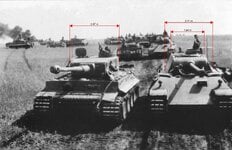Shortround6
Lieutenant General
Nope and nope.- 88mmL56 gun on the 10.5cm howitzer carriage - far less clumsy than the Pak 43, but main advantage is that it can be done fairly early, like before ww2. If Goering is against this, see what can be agreed with the Navy. It should also make the alt-Nashorn being a lower target, FWIW.
- 7.5cmL70 gun on the 10.5cm how carriage - sorta German 17 pdr for all intents and purposes.
The 88mmL56 gun in the Tiger went 1332kg including muzzle brake. The poor 10.5cm howitzer carriage is not going to stand up to that.
The 7.5cmL70 gun was about 1086kg.
The 17pdr gun was about 827kg (being around 1.5 meters shorter helped)
Not saying you can't develop a towed mount for either gun, but the standard 10.5cm howitzer carriage is not going to be a short cut.
Edit. Let's remember that the very early 17pdr on the 25pdr carriage could only aim about degrees each side without using the turntable.
Trying to point one of these high power guns 20-30 degrees off axis was not going to end well.
Last edited:

